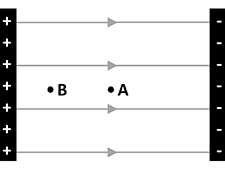
Electric potential difference
Variant i Dynamics first Other Variants Interactive tutorial lecture
Developed by Peter Shaffer (co-creator), Rand Harrington (co-creator), and Steven Kanim (co-creator)
Students interpret electric potential difference as a ratio of work done by an electric field on a charged object to the charge. The idea of path invariance is developed.
Topics Electricity and magnetism / Electrostatics: operational definitions, proportional reasoning, and vectors
Materials
Materials by the UW team
- Equipment List

- Instructor’s Guide


- Sample Pre-test


- Sample Exam Questions



Tutorial details
The tutorial begins with a review of the definition of work. Students consider an object moving from one point to another while two forces act on it. They determine the sign of the work done on the object by each force individually and the sign of the net work done on the object. Students are guided to use the work-energy theorem to relate the net work done on the object to the change in the speed of the object.
In the second section of the tutorial, students consider work done on a charged particle by the electric field due to a charged rod. By finding the work done on the particle as it travels several different paths between two points, students conclude that the work done by a static electric field is path invariant.
In section III, students consider what would happen to the work done on a particle in moving between two points if the charge on that particle is increased. They determine that the work done on the particle changes, but the quantity the work divided by the charge remains the same. This motivates the definition of electric potential difference between two points. Students find that electric potential difference between two points does not depend either on the magnitude or the sign of the charge of the particle used to measure it. Students then solve quantitative problems by applying the definition of electric potential difference and the work-energy theorem.
For instruction tips, login or register as a verified educator to see the Instructor Guide.
Prerequisites
Prerequisite tutorials
The Electric fields and flux and Gauss' law tutorials are prerequisites to Electric potential difference.
Other prerequisites
Students are expected to have worked through the tutorials Electric field and flux and Gauss’ law. They need not have been introduced to electric potential difference in other parts of the course.
The notation used for electric potential difference in the tutorial and tutorial homework is ∆VWX = VX - VW. Some textbooks use alternate notations.
Coming Soon! We hope to release the discussion section on each tutorial by the end of July 2024.

